Introduction
Presidents in India are seen as ceremonial figures who do not possess powers like the elected members of parliament who form the legislative and executive limbs of the government with direct control over policy and laws. However, an examination of the powers vested in the position of the President reveals that the President has an arsenal of powers which has an import over the legislative process and hence, the everyday lives of citizens. These include accepting or rejecting ordinances, having the power to declare an emergency, instituting the president’s rule and or accepting or rejecting mercy petitions from convicts.
This article will analyze the profiles of India’s presidents using the TCPD-PVDP dataset to comment on the political, educational and social backgrounds of India’s first citizens from 1947-2023. It must be noted that this article will include acting presidents–– an individual who occupies the office of President temporarily due to the death, resignation or impeachment of an incumbent President–– too in its analysis. It is imperative to examine the backgrounds and career trajectories of acting presidents along with elected presidents since they have the same powers as their elected counterparts.
Election to Office
For the elections of The President of India, indirect democracy is practiced where the elected representatives vote for the position and not the citizens themselves. The voters in this election are the Members of Parliament (MPs) from the Lok Sabha and the Rajya Sabha along with the Members of the Legislative Assembly (MLAs) belonging to the state and union territory (Delhi and Puducherry) legislative assemblies. However, the nominated members of the Rajya Sabha, Lok Sabha, State Legislative Assemblies (like those in Puducherry) and members of the State Legislative Council (MLCs) do not constitute the list of voters in the presidential elections. The votes are weighted based on population (for the population the census of 1971 is used). Due to this, the total number of votes counted are 10.86 lakhs.1
Coming to the acting president, he/she is mostly the Vice President of India (for example B.D. Jatti and V.V Giri). In exceptional cases, if the offices of the President and the Vice President are both vacant, then the Chief Justice of India becomes the acting President of India as Mohammad Hidayatulla notably did in 1969 for 35 days.
India’s Presidents (1950 – 2022)
The list below gives us a glimpse of the Presidents we have had and what their tenure looks like.
| Number | Name of President | Gender | Status | Term Beginning | Term Ending | Days in Office |
|---|---|---|---|---|---|---|
| 1 | Dr Rajendra Prasad | Male | Elected | 1950-01-26 | 1962-05-13 | 4490 |
| 2 | Dr Sarvepalli Radhakrishnan | Male | Elected | 1962-05-13 | 1967-05-13 | 1826 |
| 3 | Dr Zakir Husain | Male | Elected | 1967-05-13 | 1969-05-03 | 721 |
| 4 | Varahagiri Venkata Giri | Male | Acting | 1969-05-03 | 1969-07-20 | 78 |
| 5 | Justice Mohammad Hidayatullah | Male | Acting | 1969-07-20 | 1969-08-24 | 35 |
| 6 | Varahagiri Venkata Giri | Male | Elected | 1969-08-24 | 1974-08-24 | 1826 |
| 7 | Dr Fakhruddin Ali Ahmed | Male | Elected | 1974-08-24 | 1977-02-11 | 902 |
| 8 | B.D. Jatti | Male | Acting | 1977-02-11 | 1977-07-25 | 164 |
| 9 | Neelam Sanjiva Reddy | Male | Elected | 1977-07-25 | 1982-07-25 | 1826 |
| 10 | Giani Zail Singh | Male | Elected | 1982-07-25 | 1987-07-25 | 1826 |
| 11 | R Venkataraman | Male | Elected | 1987-07-25 | 1992-07-25 | 1827 |
| 12 | Dr Shankar Dayal Sharma | Male | Elected | 1992-07-25 | 1997-07-25 | 1826 |
| 13 | K. R. Narayanan | Male | Elected | 1997-07-25 | 2002-07-25 | 1826 |
| 14 | Dr A.P.J. Abdul Kalam | Male | Elected | 2002-07-25 | 2007-07-25 | 1826 |
| 15 | Pratibha Devisingh Patil | Female | Elected | 2007-07-25 | 2012-07-25 | 1827 |
| 16 | Pranab Mukherjee | Male | Elected | 2012-07-25 | 2017-07-25 | 1826 |
| 17 | Ram Nath Kovind | Male | Elected | 2017-07-25 | 2022-07-25 | 1826 |
| 18 | Droupadi Murmu | Female | Elected | 2022-07-25 | current | ongoing |
Elected or Acting
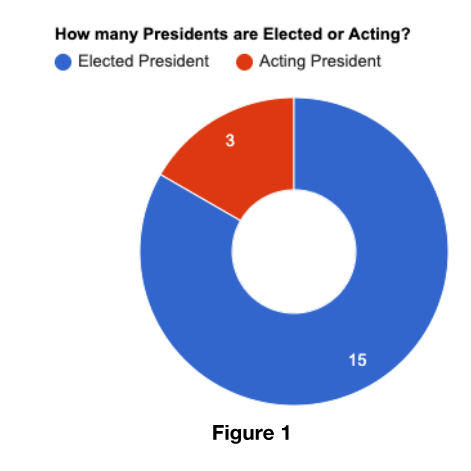
From the image above we can see that out of 18 Presidents, 15 have been elected whereas 3 have been acting Presidents. V.V. Giri was the acting President for 78 days following the death of President Zakir Hussain. After V.V. Giri resigned from the post of Acting President to contest for the elections of President as an independent candidate, Mohammad Hidayatullah (then Chief Justice of India) became the acting President filling the vacancy left by V.V. Giri. Justice Mohammad Hidayatullah is the only person who has served as the Chief Justice of India, President and the Vice President of India.2 B.D. Jatti served as the acting President of India for 164 days following the death of President Fakhruddin Ali Ahmed.3
Political Backgrounds
This section of the column will look into the political affiliations of the Presidents and the past political positions they have held over their political career.
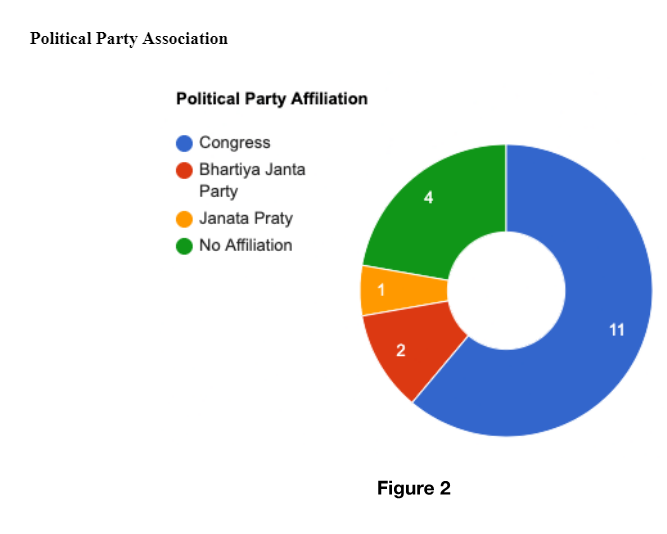
The pie charts above show that 11 or 60% of the Presidents elected to office were affiliated with the Indian National Congress. This result is not surprising considering the Congress and Congress-led alliances were voted into power for the majority of the time period of independent India. This totals 51 years of Congress-led governments if we include the 2 years of outside support they extended to the United Front government from 1996-98, making the party’s total number of terms helming power to be a whopping 11.
While the majority of India’s presidents have been affiliated with a political party, it must be noted that four presidents had no political antecedents. This also includes Acting President Justice Mohammad Hidayatullah as he was the CJI, and thus, was not a member of any party. The other three presidents were Dr Sarvepalli Radhakrishnan, Dr Zakir Husain and Dr A.P.J. Abdul Kalam. Dr Sarvepalli Radhakrishnan and Dr Zakir Husain won due to the support extended to them by the Congress whereas Dr A.P.J. Abdul Kalam (Presidentship from 2002-2007) won primarily due to the support extended to him by the BJP-led NDA. Dr Sarvepalli Radhakrishnan and Dr Zakhir Hussain were both professors whereas Dr A.P.J Abdul Kalam was a scientist.
Coming to the now-elected Bharatiya Janata Party, only 2 presidents have risen to office from the party in the past 75 years. It should be noted, however, that the BJP had supported Dr A.P.J. Abdul Kalam as an independent candidate and did not select any of its party members to contest for president in 2002.4 The only other party which has successfully elected its member as the President in addition to the e Congress and the BJP is the Janata Party successfully electing R. Venkataraman.
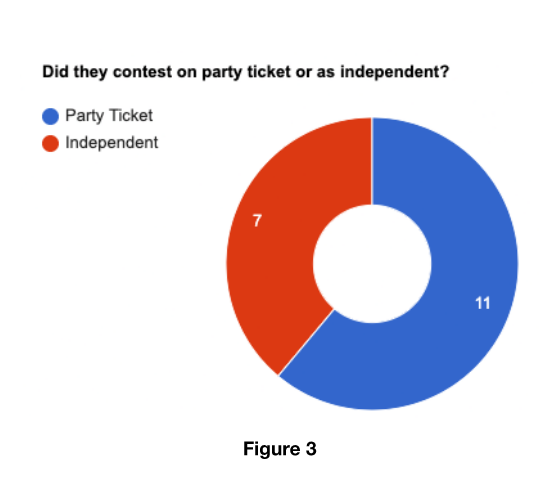
In figure 2, we can see that India has had 14 Presidents that had party affiliations but on a closer look in Figure 3, we are able to see that there are only 11 or 60% of presidents who were elected to office on a party ticket whereas 7 or 39% were independent candidates who won the majority support. Here, acting presidents have been included in the category of independent candidates as they were elevated to the office of the president without contesting on a party ticket. This is also done as V.V. Giri went on to contest as an independent and Justice Mohammad Hidayatullah was the CJI, hence, he was in a sense independent president as he had no political party allegiance beforehand.
If we were to remove the acting presidents from the figure above it would only leave us with 4 presidents who were actually independent. This goes on to show the political nature of the appointment to the post of the President and every party in power will want to install a president that believes in their ideology.
Public Offices Held
This section will break down how many public offices the Presidents have previously been a part of over their political career. The visualisations will only include 17 presidents as V.V. Giri’s political career achievements will only be counted once here as he was the acting president and was later elected to the post.
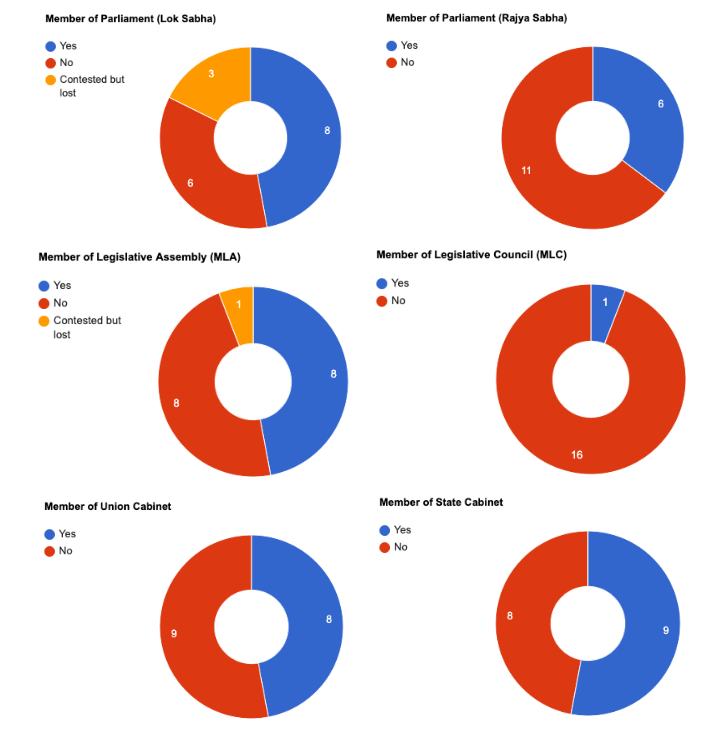
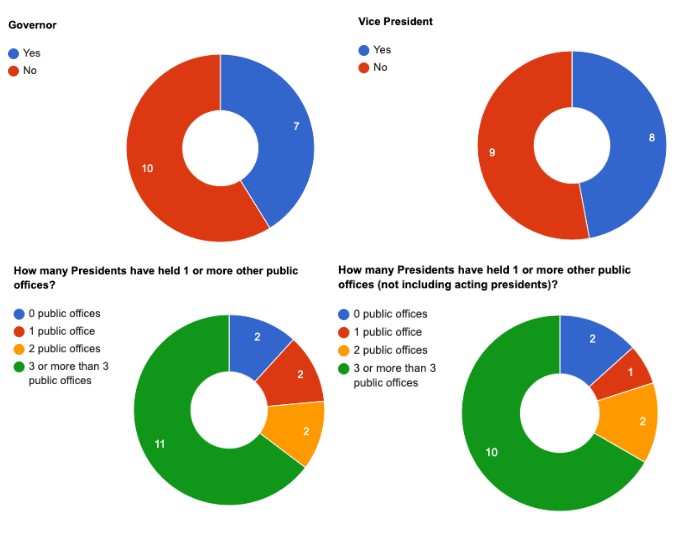
The only Presidents who have held no other public office other than the office of the President include Dr Rajendra Prasad (1st President) and Dr A.P.J. Abdul Kalam (14th President). However, it should be noted that Dr Rajendra Prasad was elected as the President of the Constituent Assembly 5 whereas Dr A.P.J. Abdul Kalam was the first Principal Scientific Advisor of India in 1999 which at that time was similar to being the member of a cabinet.6
We can see that 11 or 64% of the presidents have held more than 3 public offices whereas 13 or 76% of the presidents have held two or more than two public offices. The same trend can be seen even when we remove acting presidents and just consider the ones that have been elected.
This helps us see that a candidate is more likely to become a president if they have held three or more than three public offices.
Educational Background
The educational breakdown will help us understand the qualifications of the president and will give us an insight into what degrees they have pursued. We will be looking at the highest level of college degree they have earned.
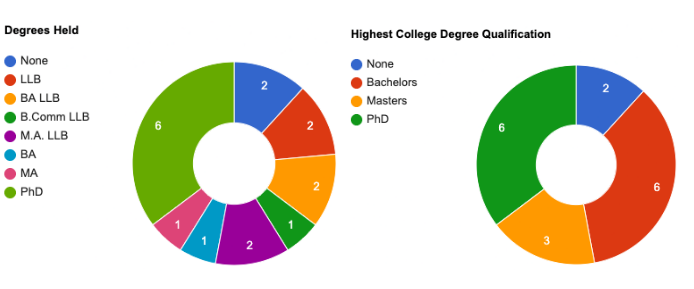
7 presidents have pursued a college degree in law from which 2 have obtained master’s degrees. As we can see, the most popular choice for a president’s degree belongs to the legal sphere. Only 2 presidents (Neelam Sanjiva Reddy and Giani Zail Singh) have not pursued a college education out of 17 which makes it approximately 10% of the total presidents. 6 presidents or 35% of all presidents have completed their PhD or Doctor of Philosophy.
| Number | Name of President | Educational Qualifications |
|---|---|---|
| 1 | Dr Rajendra Prasad | PhD |
| 2 | Dr Sarvepalli Radhakrishnan | PhD |
| 3 | Dr Zakir Husain | PhD |
| 4 | Varahagiri Venkata Giri | BA LLB |
| 5 | Justice Mohammad Hidayatullah | BA LLB |
| 6 | Varahagiri Venkata Giri | BA LLB |
| 7 | Dr Fakhruddin Ali Ahmed | LLB |
| 8 | B.D. Jatti | LLB |
| 9 | Neelam Sanjiva Reddy | NA |
| 10 | Giani Zail Singh | NA |
| 11 | R Venkataraman | PhD |
| 12 | Dr Shankar Dayal Sharma | PhD |
| 13 | K. R. Narayanan | MA |
| 14 | Dr A.P.J. Abdul Kalam | PhD |
| 15 | Pratibha Devisingh Patil | MA LLB |
| 16 | Pranab Mukherjee | MA LLB |
| 17 | Ram Nath Kovind | B.Comm LLB |
| 18 | Droupadi Murmu | BA |
Gender Profile
The above pie chart tells us the gender breakdown of the presidents. India has only 2 female presidents in comparison to 15 male presidents. With 15 male presidents and only 2 female presidents, the gender gap speaks volumes about the participation and representation of Indian women in the country’s governance. Here, it becomes essential to recognise that this gender inequality is extremely visible, given the post of the President. The same can consequently greatly impact how gender roles and representation are engaged within the larger societal aspect.
Conclusion
By the end of this piece, we can see how the office of the President is not merely a ceremonial position and has deep political repercussions. We could see a strong correlation while checking the public offices that as one assumes more public offices the chance of becoming a President becomes higher. At the same time, we could see that the post of the President was acquired by highly educated individuals, the majority of whom pursued law during their education. Towards the end, we were able to see that one thing that the position lacks is gender diversity with only 2 women ever assuming the post, the first one being Pratibha Patil who only assumed office in 2007.
With this piece, I hope people look into the profiles of the Presidents and think about how vital this political office is and the greater repercussions it could have in terms of the social and political life of India.
About
Raghav Puri is completing his postgraduate diploma degree at Ashoka University where he is pursuing History. He has previously majored in Political Science and International Relations.
References:
1 G, Manoj C. “Explained: How the President of India Is Elected.” The Indian Express, 21 July 2022, https://indianexpress.com/article/explained/explained-how-the-president-is-elected-7961048/.
2 Desai, P D. “Full Court Reference in Memory of The Late Justice Mohammad Hidayatullah.” Eastern Book Company – Practical Lawyer, http://www.ebc-india.com/lawyer/articles/92v4a2.htm.
Lok Sabha. “All Members of Lok Sabha (Since 1952).” Members: Lok Sabha, https://loksabha.nic.in/Members/lokprev.aspx.
3 “TCPD Presidents and Vice-Presidents of India Dataset (TCPD-PVPD), 1950-2021”, Trivedi Centre for Political Data, Ashoka University.
4 New Indian Express. “When Vajpayee’s Nominee Kalam Cruised to Victory.” The New Indian Express, The New Indian Express, 17 Aug. 2018, https://www.newindianexpress.com/nation/2018/aug/17/when-vajpayees-nominee-kalam-cruised-to-victory-1858920.html.
5 Parliament Library. Dr Rajendra Prasad. http://loksabhadocs.nic.in/Refinput/eprofiles/English/02122021_163540_1021206167.pdf.
6 Office of the Principal Scientific Adviser. “Former Principal Scientific Advisers to the Government of India.” Principal Scientific Adviser, https://www.psa.gov.in/innerPage/psa-initiatives-covid/former-principal-scientific-advisers-government-india/3827.
Disclaimer
This article belongs to the author(s) and is independent of the views of the Centre.

